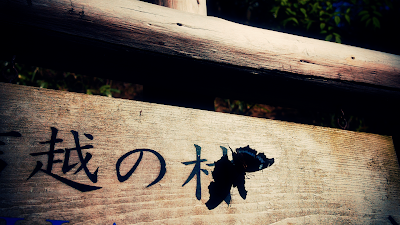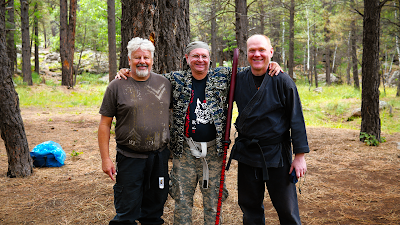Do You Have Enough ゆとり Yutori to do Bujinkan Shadow Techniques?
From Bujinkan Santa Monica by Michael
 |
| Shadows in Soke's window, photo by Michael Glenn |
My students were very surprised. But so was I. I have seen Hatsumi Sensei apply locks before where the opponent’s body just seems to assume the form of the lock without any contact from Soke. I first heard Soke describe these “shadow techniques” (kage no waza) during one of my trips to Japan in 2003.
I never understood them before and definitely never thought I would be able to do them. But during my trip to Japan this last summer, Soke helped me put the final pieces of this puzzle in place. So now here I am, surprising myself with my own kage no waza.
You must train deeply to learn all the elements that make kage no waza mysteriously arise in the kukan. And I have been puzzling over this ability for years in my own training. Here is one key piece of the puzzle that Hatsumi Sensei personally shared with me so I could go home and study his feeling.
We were practicing multiple attacker scenarios in the Bujinkan Honbu dojo. One attacker grabs both of your wrists, the other kicks or punches at you. Then Soke told us,
“Don’t try to control him right away, just have a lot of ゆとり yutori (breathing room; elbowroom; leeway; room; reserve; margin; allowance; latitude; time). The connection is very important. You don’t have to throw him or show anything pretty.”We all tried to do as he said, but most people in the dojo fought with their partners. Hatsumi Sensei laughed while he watched me struggle with my opponents. He took pity on me and came over and asked my to grab his wrists. Then, my two training partners attacked him.
From the moment I grabbed him, I felt like a pawn. He was using my own attempt to grab as a weapon against all of us. He very casually tangled us up and left me floating in space with my training partners collapsed beneath me on the tatami. I had to twist my body just to not fall on top of them.
Soke stood there laughing at me as I hung in the air. Everything he did was so casual. There was no rush, no force. When I recovered my balance he told me,
“You do this without waza. Wakarimasuka? Do it with tsunagari.”Not with technique, only through 繋がり tsunagari, which is connection. Did I understand? Usually when something is above my skill level, I understand things intellectually or in theory. But this time I understood the feeling with my body. And something more…
Hatsumi Sensei decided to share more of this lesson with the whole dojo. He said,
“Use your elbow here. Don’t try to do anything, just put it out there. Keep it attached to your body. Study this way of connecting one to the other. Don’t show that you’re trying to take something…Ha! This is what I wanted to tell my own students last night. They stood there looking at me like I had done a magic trick. But it was just an extension of the training I had done with Hatsumi Sensei. This is the kind of magic that fuels ninja mythology. So we are very lucky to find it in our everyday Bujinkan training.
…remember that the connection is the reality. It’s the waza, but it’s not the waza.”







